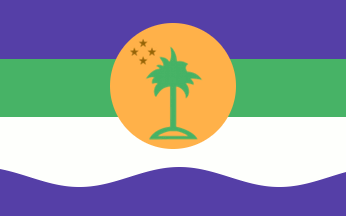 image by Dirk Schönberger,
10 November 2012
image by Dirk Schönberger,
10 November 2012Source: http://pt.wikipedia.org/wiki/Ilha_Comprida

Last modified: 2012-12-15 by ian macdonald
Keywords: sao paulo | ilha comprida |
Links: FOTW homepage |
search |
disclaimer and copyright |
write us |
mirrors
 image by Dirk Schönberger,
10 November 2012
image by Dirk Schönberger,
10 November 2012
Source:
http://pt.wikipedia.org/wiki/Ilha_Comprida
Four horizontal stripes, blue-green-white-blue, with the field boundary between the lower two stripes being wavy, over the top three stripes a centrally placed orange disk with a green palm tree on an island and four stars of the Southern Cross above it.
Official website at
http://www.ilhacomprida.sp.gov.br
Dirk Schönberger,
10 November 2012
Ilha Comprida was discovered in the 16th century by the adventurer Cosme Fernandes Pessoa. Nicknamed "Bacharel" (Bachelor), Pessoa is said to have studied at the Coimbra University and to have been a prominent member of the court of King Manuel. Disgraced and demoted for obscure reasons, he joined the expedition led by Amerigo Vespucci that reached Ilha do Bom Abrigo (Good Shelter Island), located south of Ilha Comprida. After having landed on Ilha Comprida, Pessoa was captured by the Tupis, but quickly gained their confidence and married a daughter of the local cacique. In 1531, Martim Afonso de Souza's fleet landed in Ilha do Bom Abrigo; the colonizer decided, however, to establish a settlement on Ilha Comprida, named Maratayama or Vila dos Tupis, that would exist for the next 80 years. In 1534, the Spanish refugee Rui Garcia de Mosquera built a fort he sued as headquarters for the pirate expeditions he led with his good friend Pessoa. In the early 17th century, the Portuguese Crown took control of the island and divided it into domains ("sesmarias"). The town of Nossa Senhora da Conceição da Marinha was founded around 1700. In the beginning of the 20th century, the town of Pedrinhas emerged as a center of fishing and extraction. The territory of the island was shared in 1919 between the municipalities of Iguape (70%) and Cananéia (30%). Tourism and urbanization started in the 1950s. In a plebiscite organized on 27 October 1991, 87% of the voters approved the establishment of the municipality of Ilha Comprida, which was obtained on 5 March 1992. Ilha Comprida was proclaimed a State Protected Area in 1987. On 7 December 1992, Ilha Comprida was awarded the title of Sea Resort. Beaches spread over 74 km in a row, being part of an endangered ecosystem also including dunes and mangroves. The island is listed as one of the four main spots of migratory bird diversity in South America.
The flag of Ilha Comprida is horizontally divided blue-green-white-blue, the division between the two lower stripes being wavy. Over the three upper stripes is placed a yellow disk charged with a green palm tree and four black stars in canton.
Photo of the flag; 27 May 2010 http://www.portalvaledoribeira.com.br/2010/05/27/prefeito-da-ilha-comprida-anuncia-investimentos-e-retomada-de-projetos-sustentaveis
[The odd shades used on the source drawing are, as expected, not
supported by the photo of the flag. They should be corrected to usual
shades. The stars appear to be black rather than brown.]
Ivan Sache, 11 November 2012